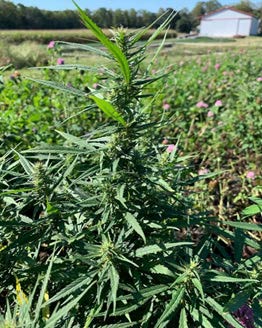Developing and Implementing Insect Pest, Diseases and Weed Monitoring and Managing tactics on Hemp Production in the Delmarva Region
Dwayne Joseph – University of Maryland Extension Educator, Kent County
Simon Zebelo – Professor, Department of Natural Sciences, University of Maryland Eastern Shore
Kurt Vollmer – University of Maryland Extension Specialist, Weed Management
Alan Leslie – Center Director WMREC, CMREC, LESREC, University of Maryland
Cerruti Hooks – Professor, Department of Entomology, University of Maryland

Integrated Weed Management (IWM) is crucial in hemp production due to limited herbicide options, with only one conventional herbicide approved for use in the US. Additionally, research on weed management in hemp is limited following its recent removal from the controlled substance list. Weeds pose a significant challenge to hemp growers, especially in controlling broadleaf varieties. This challenge was evident in a University of Maryland Eastern Shore pilot program where growers struggled with Palmer amaranth and common ragweed. Weeds also negatively impacted profit margins due to the high labor costs associated with hand weeding. Hence, there is a pressing need to develop new weed management strategies to reduce production costs. Cover cropping emerges as a promising aspect of IWM programs for both standard and plasticulture-grown hemp. Therefore, this study aims to evaluate the effectiveness of conservation tillage, cover cropping, and other integrated tactics on weed control and floral hemp yield.
Methods
Plot preparation
The study was laid out in a randomized complete block design with four replications. Treatments included bareground (BG), premium clover mix (PCM), and Teff red clover (Teff-RC).
Fall – In early fall, a cover crop mixture consisting of four different clover cultivars was planted in BG and PCM plots at 12 lbs/acre with 6-inch row spacing. Cereal rye was seeded in Teff-RC plots.
Spring – In early spring, cover crops in BG plots were mowed and disked under, followed by laying 3 ft-wide black plastic mulch with a plastic mulch bed layer. In Teff-RC plots, the entire plot was mowed to terminate the rye before laying black plastic mulch. Teff and red clover were then planted between the plastic-mulched rows at 6-inch row spacing and rates of 12 and 15 lbs/a, respectively. In PCM plots, 40-inch-wide strip rotovation was done in intra-row areas, with black plastic and drip lines laid in these zones, while clover remained in the inter-row areas as a living ground cover.
Data sampling
Weeds – Weed density and visual percent cover measurements were collected at 1, 2, 3, and 5 weeks after planting (WAP). During each assessment, 100 sq-inch quadrats were randomly placed in each plot within two inter-row areas. Weeds were identified, counted, and visually rated for the percentage of ground covered by cover crop, weeds, and bare soil. Visual percent ground cover assessments ranged from 0% (no soil cover) to 100% (total soil cover).
Crop growth & yield – Hemp height and width were measured on six selected plants per plot every 14 days after transplanting until flowering. Once flowering began, crop maturity was assessed by measuring the total THC content of random plants in each treatment to ensure compliance with the 0.3% THC limit at harvest. Subsequently, four plants were randomly harvested from the center rows of each plot and weighed for fresh mass before being air-dried to approximately 10% moisture content. After drying, each plant was weighed again for dry mass, and colas were clipped from branch terminals and weighed separately.
Results & Discussion
Data relating to weed density, weed counts, and hemp growth and yield from the 2023 trial-year of this study are yet to be analyzed. Therefore, no official numbers will be reported at this time. However, from visual observations, it can be noted that the living mulch system offered a superior weed management technique compared to bareground (no cover crop). Preliminary observations suggest that the PCM plots had the least number of weeds present at all sampling times. Teff-RC plots also showed a low number of weeds, although slightly more than PCM plots. The hemp plants were initially small at transplant and remained so throughout the growth sampling times. They fell short of the expected size requirements, with only a few colas present at the final harvest, which is significantly less than what is typical for the Cherry Wine cultivar. In fact, the plants in the study only reached approximately a quarter of the size they typically achieve (Figure 2). We attribute this to the small size of the transplants received from the nursery and the late planting date. These issues will be addressed in the next trial year by growing larger transplants 2-3 weeks earlier. These adjustments should help the plants meet maturity milestones on schedule, as they had to contend with early-season shading by the living mulch, which may have contributed to their stunted growth. There appears to be promise in this IWM approach for floral hemp growers. However, a more comprehensive assessment will be possible after data analysis and implementing the aforementioned changes for the next growing season. This will provide a clearer

Figure 1. Left, Teff-RC plot 1 week after transplant, and Right, PCM plot 1 week after transplant.

Figure 2. Left, Cherry Wine plant 10 weeks after transplant in PCM plot, illustrating its notably small size, and Right, Cherry Wine plants 12 weeks after transplant, displaying the typical size they can achieve.